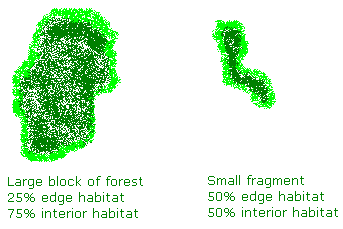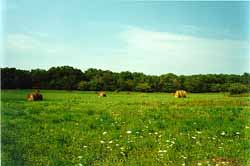
Almost seventy per cent of all forest parcels in Illinois are between 40 and 200 acres in size, and the majority of remaining high quality forests in Illinois are less than one hundred acres in size.
Edge
versus interior habitat
Forest
fragmentation decreases plant and animal diversity.
A small, fragmented forest parcel has a larger proportion of edge habitat
for its size than a larger forest.

A number of animals favor this area between two habitats, called edge habitat, there are many species of forest animals, birds in particular, that require larger, uniform blocks of land in order to breed and raise young successfully. These animals are called "area-sensitive" species.
Area-sensitive
species need larger habitats
The meaning
of this fragmentation is clearer when you consider the fact that many birds
that live deep within forests require up to 600 acres to thrive as a population.
Two of these species are the Ovenbird (Seiurus aurocapillus) and
Acadian Flycatcher (Empidonax virescens). The number of these species
has decreased because many of the forests fragments are too small for them.
Other
species take their place
Increases
in edge habitat and a decrease of unbroken blocks of forest result in increases
in populations of species like deer and Brown-headed Cowbirds (Molothrus
ater).
 |
Edge habitat at Star Grove, Midewin Nation Tallgrass Prairie |
Brown-headed Cowbirds take over the nests of native songbirds such as the Ovenbird (Seiurus aurocapillus) (popup window with image) reducing their ability to raise their young successfully.
Increased deer populations can damage the vegetation and structure of the forest. The quality of the habitat is reduced, leading to a decrease in the diversity (number of different types) of animals and plants that live there.
Isolated
populations
Forest
fragmentation also results in smaller, more isolated populations of plants
and animals. There are fewer corridors of forest connecting forest fragments.
When a population of an animal species is isolated in a small forest fragment,
unfortunate situations can occur.
- It is difficult for them to expand their habitat as they grow in number because the next fragment is far away or unsuitable.
- Individuals in this small group can only breed amongst themselves. The gene pool may have or may develop weaknesses such as susceptibility to a disease or physical weaknesses. The whole group could be more easily wiped out than a group with a mixed gene pool.
- If a flood or fire disturbed this small habitat or eliminated it, the isolated group would be less likely to survive than if they had a larger habitat or a place to which to escape.
|
|
Copyright © 2000 Illinois State Museum